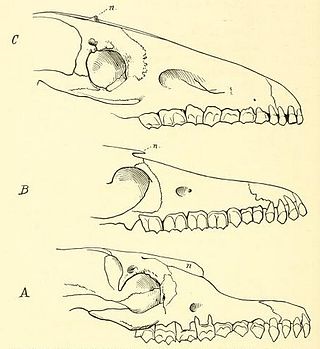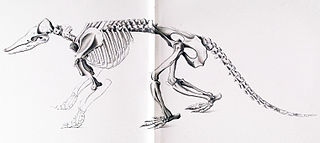Classification
The genus Coscinocercus was first described in 1939 by Cabrera, based on fossil remains found in the Argentine pampa, in Late Miocene terrains. Two species were attributed to this genus, Coscinocercus marcalaini and C. brachyurus, mainly distinguished by specifities of the carapace, that might only be intraspecific variations.
Coscinocercus was a member of the tribe Hoplophorini, a clade of glyptodonts. It was related to the genera Plohophorus and Phlyctaenopyga . Some evidences tends to suggest that it was synonymous with another Late Miocene genus, Pseudoplohophorus
Huayqueriana is an extinct genus of South American litoptern, related to Macrauchenia, and belonging to the same family, Macraucheniidae. It was formerly known as Macrauchenidia latidens, described in 1939 by Cabrera, but redefined as Huayqueriana in 2016 based on the earlier name convention of Rovereto 1914. The genus is named after the Huayquerías Formation and the eponymous Huayquerian South American land mammal age defined at the formation.

Scalabrinitherium is an extinct genus of mammals of the family Macraucheniidae. Fossils of this animal were found among the fossils of prehistoric xenarthrans in the Ituzaingó Formation of Argentina.

Hoplophorus is an extinct genus of glyptodont, a subfamily of armadillos. The only confidently known species was H. euphractus, found in Pleistocene deposits in Brazil, though fossils possibly from another species are known from Bolivia.

Propalaehoplophorus, also written as Propalaeohoplophorus, is an extinct genus of glyptodont, which lived in South America during the Early Miocene epoch.

Stegotherium is an extinct genus of long-nosed armadillo, belonging to the Dasypodidae family alongside the nine-banded armadillo. It is currently the only genus recognized as a member of the tribe Stegotheriini. It lived during the Early Miocene of Patagonia and was found in Colhuehuapian rocks from the Sarmiento Formation, Santacrucian rocks from the Santa Cruz Formation, and potentially also in Colloncuran rocks from the Middle Miocene Collón Curá Formation. Its strange, almost toothless and elongated skull indicates a specialization for myrmecophagy, the eating of ants, unique among the order Cingulata, which includes pampatheres, glyptodonts and all the extant species of armadillos.

Neosclerocalyptus was an extinct genus of glyptodont that lived during the Pliocene, Pleistocene, and Holocene of Southern South America, mostly Argentina. It was small compared to many Glyptodonts at only around 2 meters long and 360 kilograms.
Cullinia is an extinct genus of litoptern, an order of South American native ungulates that included horse-like and camel-like animals such as Macrauchenia. It is only known from fragmentary remains. Cullinia levis is known from Chasicoan remains found in the Arroyo Chasicó Formation of Argentina, and remains from the Brazilian state of Acre and the Huayquerian Ituzaingó Formation have been assigned to Cullinia sp..
Neoglyptatelus is an extinct genus of xenarthran, belonging to the order Cingulata. It lived from the Middle to the Late Miocene, and its fossilized remains are found in South America.
Proeuphractus is an extinct genus of xenarthran, related to the modern armadillos. It lived from the Early to the Late Miocene, and its fossilized remains were discovered in South America.

Prozaedyus is an extinct genus of chlamyphorid armadillo that lived during the Middle Oligocene and Middle Miocene in what is now South America.
Protoglyptodon is an extinct genus of Glyptodont. It lived during the Late Miocene, and its fossilized remains were found in South America.
Palaehoplophorus is an extinct genus of glyptodont. It lived from the Middle to the Late Miocene, and its fossilized remains were discovered in South America.
Urotherium is an extinct genus of Glyptodont. It lived from the Late Miocene to the Late Pliocene, and its fossilized remains were found in South America.
Plohophorus is an extinct genus of Glyptodont. it lived from the Late Miocene to the Late Pliocene, and its fossilized remains were discovered in South America.
Phlyctaenopyga is an extinct genus of Glyptodont. It lived from the Late Miocene to the Early Pliocene, and its fossilized remains were discovered in South America.
Eosclerocalyptus is an extinct genus of glyptodont. It lived during the Late Miocene, and its fossilized remains were discovered in South America.
Comaphorus is a dubious extinct genus of glyptodont. It lived during the Late Miocene in Argentina, but only one fossil has ever been referred to the animal.
Asterostemma is an extinct genus of glyptodont. It lived during the Middle Miocene, and its fossilized remains were discovered in South America.

Cochlops is an extinct genus of glyptodont. It lived from the Early to Middle Miocene, and its fossilized remains have been found in South America.
Dasypus neogaeus is an extinct species of armadillo, belonging to the genus Dasypus, alongside the modern nine-banded armadillo. The only known fossil is a single osteoderm, though it has been lost, that was found in the Late Miocene strata of Argentina.
This page is based on this
Wikipedia article Text is available under the
CC BY-SA 4.0 license; additional terms may apply.
Images, videos and audio are available under their respective licenses.









